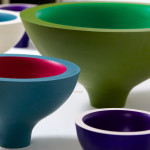It would be fair to describe Nicholas Rena’s work progress as glacial. The term was carefully selected and not meant to be derogatory. Artists work at different speeds. Some sprint others take a slow incremental pace, seeking the eventual perfection of a singular idea and a narrow path. There can be a lot of power in the latter choice.
The glacier in this case represents more than gradual movement, it’s a much broader metaphor; the notion of powerful mass on the move taking a journey not measured in years but in decades.

It fits Rena for many reasons including that mass rather than volume is his métier. Yes, he works with volume as well but it serves mass and not vice versa. Volume shelters in his architecture. The thick walls with their flat sharp rims would give his pots an almost forbidding quality, fortress-like, and would be daunting if the were it offset only by the fresh, optimistic color he gets from staining with ink. Imagine them in black.

Rena has created an installation of new monumental bowls for the Holburne’s Ballroom table, a setting, with astonishing qualities of light and rich historical resonances, described by the museum “orderly yet vigorous, painted and waxed to a flawless finish…[that] evoke both the ceramics of Lucie Rie and still-lifes by Matisse”.

While the Matisse connection is evident in the color selection and is backed by career long reverence of this painter on Rena’s part, the Lucie Rie evocation is more complex and subject to doubt. On the one hand the outer silhouette of his bowls is certainly recognizable as a classic shape from this Austrian potter with its elegant swooping foot.

Purists might (and I am sure do) argue that these ceramics are the antithesis of Rie’s art. After all, wasn’t Rie defined by her lightness of form (actually that is by no means always true) and her elegant refinement of line? Had Rena not been replaced her with a heavy-handed cartoon?

Rena’s bowl is actually refined or if you prefer, reductive, pure in its minimalism. And as for being a cartoon it is really a Pop rendering which has elements of the former but is much more. Would she approve? Knowing her, I doubt it, not entirely. Her tastes could be narrow when it comes to clay and a bit conservative. But I am sure with her roots in early Modernism that Rie would recognize and applaud the art in this work.
Rena was taught ceramics by the highly regarded artist Gordon Baldwin at Eton. Then he studied architecture, training with architect Eric Parry. Disillusioned with architecture as a career, Rena returned to ceramics and studied at the Royal College of Art, soon after winning the Jerwood Prize in 2001.
“My architectural background’, says Rena in the museum literature, “has [remained] the perspective in my work, a consideration and preoccupation with space.”
Either by intent or chance, the extension to Holburne Museum, with its stunning ceramic façade is the work of Parry so CFile has an accompanying post this week on this building, a modest tribute to pedagogy.

In the current issue of Crafts magazine Rena says: “I think this belongs to the same tradition as the arrays that Edmund de Waal does. But what I’m trying to do with this new form is my homage to Lucie Rie but injecting a bit of Matisse-style color which is not terribly British. I can’t help myself, I do prefer the volume turned up.”

In his artist statement Rena points out that the central metaphor for the bowls is perhaps too obvious to state, they are empty:
They are empty because they refer to traditions of use that are almost lost: ceremonies or rituals, involving vessels, which were performed in common, such as baptism, anointment, invocation, blessing…where man and the material world fused. Perhaps these empty objects do have some function. In a world dematerializing into an anti-physical one of text and images, of speed and noise, they sit heavy, thick and still. Material trying to be as palpable as it can, reproaching a world going virtual.

The installation viewed behind plastic scrim is certainly joyful and viewers seem always to be smiling. The photography, commissioned by the museum for the exhibition from Evoke Studio and Phil Sayer, both this upbeat quality and the installations intent to be an seen as ensemble is very clearly projected. No photograph shows a single piece on its own, few are shown in their entirety, instructing us that After Matisse is about mise-en-scène, about the collective impact and that even a fragment is empowered to speak for the whole.

This installation is the second of five contemporary interventions at the Holburne supported by Arts Council England.
Garth Clark is the Chief Editor of CFile
Any thoughts about this post? Share yours in the comment box below.

Nicholas Rena

Is that glaze? Such vibrant colours!
Garth, these pieces are so elegant. They look like ceramic effigies of the head of my bathroom plunger!
xoxo
DF